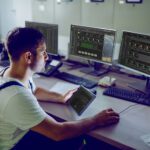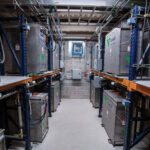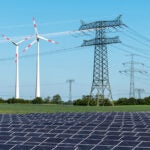Today’s electric power grids are evolving at an alarming pace. Distributed energy resources are quickly taking the place of central power stations, making grid operators’ jobs of managing power flows in the system more difficult. Intelligent remote monitoring solutions can help.
Electrical grids have undergone massive change over the last decade. Once static, hub-and-spoke networks extending out from a central power plant and control center, grids today are decentralized while constantly growing and contracting to meet dynamic electricity demands. Power is increasingly being produced on the edge through residential solar and other renewable sources, and consumed inconsistently through electric vehicle charging stations and other electrification trends (Figure 1). These are not your parents’ electrical grids. They are seemingly living, breathing networks that power our homes, businesses, transportation systems, and economies.
 |
|
1. Power grids around the world are changing and the evolution is expected to continue. Electrification trends, including the adoption of more electric vehicles, will force power systems to expand, making intelligent remote monitoring systems even more important in the future. Source: Shutterstock |
The increasing importance of the grid has also transformed business models. Electric utilities are no longer in the business of producing power. Instead, they deliver power across an increasingly complex, dynamic electrical grid. Power generated on the edge of the network needs to be managed, modulated, and delivered on demand to wherever it is needed, across increasingly complex electrical infrastructure. This requires the ability to monitor the health and performance of a growing list of assets and to take immediate action to ensure balance and prevent outages.
However, the growth and increasing complexity of these networks are outpacing the ability of human operators. It’s simply not practical anymore to have human operators sifting through terabytes of monitoring data across thousands of assets—wading through thousands of signals and alarms each day to differentiate between issues that are actionable and issues that are statistical noise. New technology is needed to take pressure off human operators without putting assets, the grid, and customer experience at risk.
A Modern Approach to Remote Monitoring
Ameren, a Fortune 500 electrical utility operating in Missouri and Illinois, is currently transforming the way it operates given these challenges. And, it’s doing so with the help of innovative technology and Hitachi Energy.
Traditional remote monitoring solutions provide near-real-time control and analysis of grid production and health, as well as predictive optimization and planning. But Ameren has embraced new intelligent remote monitoring solutions powered by artificial intelligence (AI) and machine learning (ML) to deliver continuous insights that were never available before. Its operators can use the information to automate actions based on pre-set triggers or take actions themselves to ensure optimal health and performance, and extend life of assets. And they can do this without having to employ an army of control room operators or field technicians.
Intelligent remote monitoring solutions allow Ameren’s operators to watch energy flow, turn generating sources on and off, monitor energy quality, warn technicians about live wires, and conduct other actions remotely and automatically—with the ultimate goal of facilitating safe and efficient day-to-day operations while minimizing long-term capital expenditures.
Moving Intelligence to the Edge
Intelligent remote monitoring solutions can enable even more agility by moving the intelligence out to the edge of the network in substations where it is closer to distributed assets. Transformers now come with central processing units built in, and they are connected to the internet through wireless routers. This eliminates the need to bring data all the way back to a central control center to analyze. Instead, Ameren’s operators can now make and automate decisions out on the edge.
Armed with this intelligence and connectivity, Ameren’s assets in the field can communicate with each other, exchange information, and train themselves to optimize performance and availability (Figure 2). They can automatically balance electrical load, failover transformers, and take other proactive actions to prevent overload or failures on a granular level before they happen without human intervention.
 |
|
2. Intelligent and well-connected remote monitoring systems allow a wide range of assets to communicate with each other. Meanwhile, artificial intelligence and machine learning tools enable automated actions that can assist operators in maintaining a reliable and resilient power grid. Courtesy: Hitachi Energy |
Five Considerations
But not all intelligent remote monitoring solutions are created equal. Here are five things to watch for when evaluating a solution for your unique needs.
Unified Network Management. Operators are dealing with growing, increasingly complex grids, making it essential that they have complete visibility across traditional boundaries of transmission and distribution networks. Look for a remote monitoring solution that provides operators with a single, unified view of the whole electrical network that delivers enhanced situational awareness and advanced network applications. This includes remote supervisory operation, advanced distribution management, transmission management, generation management, and market management—all in a single, intuitive view.
Intelligent Automation. Remote monitoring isn’t just about visibility—it’s just as much about control. Utilities can build triggers into their remote monitoring solutions that automatically kick off an action based on pre-set conditions. This streamlines workflows, frees up time for your operators, and speeds time to resolution. For example, a utility can integrate its asset management solution with workorder management to automatically create a work order for a downed asset.
Self-Healing Powered by AI/ML. Some of these automated actions can revolve around self-healing. Intelligent remote monitoring solutions can use AI and ML to make the grid less prone to outages. Imagine that a storm takes out a series of transformers in an area. Typically, a technician would be sent out to make repairs and get the system back up and running, but customers could be out of service until the service call is complete. A service mesh would automatically reconfigure the network to close the coverage gap. Operators could then work with technicians in the field to get the damaged equipment back online. This is done through self-healing algorithms that train themselves to identify and resolve issues on the fly.
Visualization. No one wants to look at spreadsheets and databases all day. Your intelligent remote monitoring solution should have a visualization engine built in that presents pertinent data in a way that operators can easily and quickly understand and take appropriate action. Alerts should be color coded and conspicuous, and should provide all the necessary context needed for resolution. Standard and custom reports should be intuitive and easy for non-technicians to understand.
Scalable and Elastic. Grids will continue to grow in size and scope, and your remote monitoring solution needs to scale in step. Who knows what tomorrow’s technology will bring? It’s important that you build for today but plan for tomorrow. This requires a flexible, modular architecture built on open-source platforms so you can essentially plug in new assets and third-party systems easily and seamlessly with little or no configuration required. You may also want to consider a hosted solution built for the cloud that gives operators visibility and control wherever there is an internet connection. In terms of features, start with monitoring and then expand as needed to include control, reporting, redundancy, and network topology in response to current and future needs.
Build for Today, Design for Tomorrow
Today’s grids are nothing like the grids of yesteryear. They are decentralized and dynamic, and need to be carefully and intricately managed and modulated to deliver electricity on demand to wherever it is needed. Human operators need help. Thankfully, intelligent remote monitoring solutions powered by AI/ML provide near-real-time control and analysis of grid production and health as well as predictive optimization and planning.
Make sure you look for a solution that provides unified network management; can streamline workflows through automation; is self-healing; presents alerts and other information in a compelling, visual manner; and can grow in size and scope with your electrical grid. Doing so will result in operational efficiencies, renewables integration, improved reliability, and grid resilience—essentially a future-proof electrical grid built for today’s capabilities and designed for tomorrow’s opportunities.
—Bryan Friehauf is senior vice president of Enterprise Software Solutions at Hitachi Energy.










